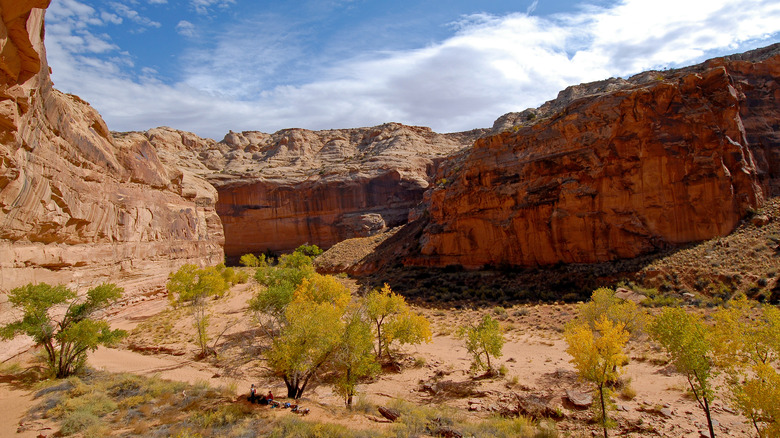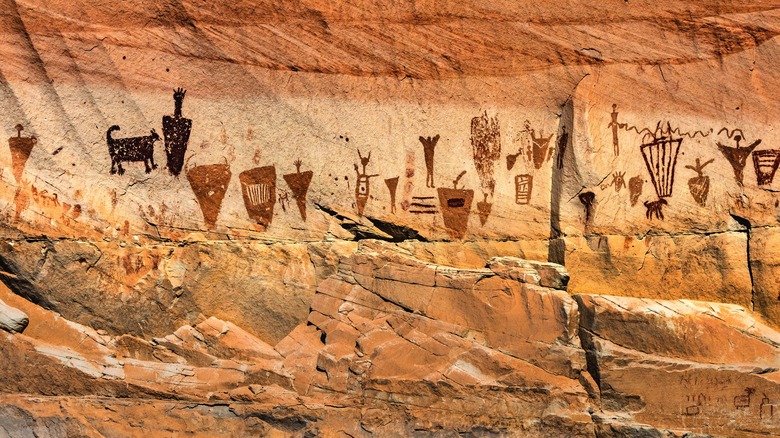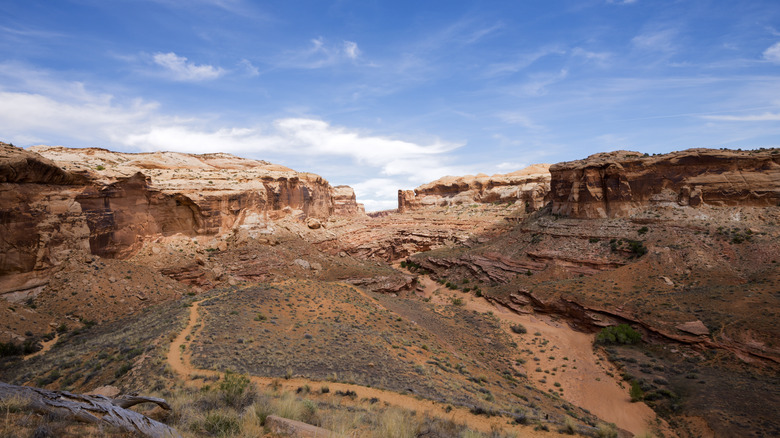Utah's Great Gallery Is Ancient, Mysterious Art On Large Sandstone Cliffs In A Red-Rock Canyon
Utah's "Mighty Five" national parks are something of an open secret within the outdoor community. With five spectacular national parks spread out across some of America's most unique landscapes, they offer an unforgettable experience for road trips and rugged backcountry hikes alike. However, not every national park in the Beehive State gets the same level of acclaim as others. For years, Canyonlands National Park has been the least-visited of Utah's five national park sites. And with Canyonlands bucket list hikes like the notorious Maze being infamously dangerous, Canyonlands arguably offers the most "authentic" experience of Utah's wilderness. Yet Canyonlands is much, much more than a magnificent and foreboding desert canyon system. Some of Canyonlands' most amazing gems are the geological and cultural treasures preserved at the unsung Horseshoe Canyon.
Horseshoe Canyon is located in a remote extension of the national park to the north of the Maze region. With the word "canyon" right in its name, and the fact that it's part of a national park called "Canyonlands," you can correctly assume that Horseshoe Canyon features outstanding canyon scenery indicative of Utah's otherworldly beauty. And yet, while Horseshoe Canyon's impressive views are certainly worth the trip, it's the canyon's cultural resources that make it stand out. Etched onto a large cliff face known appropriately as "the Great Gallery" are some of North America's largest and best-preserved examples of ancient rock art. A hike through Horseshoe Canyon will take you face-to-face with these priceless Indigenous artifacts while providing the once-in-a-lifetime canyon views that make Canyonlands so magical.
What is the Horseshoe Canyon's Great Gallery?
Native peoples throughout the Americas developed rich artistic traditions thousands of years before European colonization. Even today, the United States has several awe-inspiring destinations where you can see preserved rock art created millennia ago. All of these locations are worthwhile destinations, but Horseshoe Canyon stands out for the size and scope of its impressive pictographs. While many extant pictographs and petroglyphs are relatively small, Horseshoe Canyon's Great Gallery measures 15 feet tall and 200 feet long. The gallery's humanoid figures are often human-sized, with a few even larger. These figures also stand out for their complex style, often featuring elongated or fantastical limbs and intricate, otherworldly geometry. Alongside the humanoid figures, there are also several paintings of animals, including what experts believe to be snakes, birds, and large terrestrial mammals.
Determining a precise age for these rock paintings has proven to be quite difficult, but experts believe that they were created during the Late Archaic Period, between 2000 B.C. and A.D. 500. These particular markings represent an ancient artistic tradition known as Barrier Canyon Style, a notably rich style found throughout the canyons and rocky regions of Utah. The canyon's impressive natural splendor only adds to its overall effect. Like the other spectacular canyons spread out across Canyonlands National Park, Horseshoe Canyon features prominent red sandstone walls decorated with groves of cottonwood, lovely desert streams, and even wildflowers in the spring. The overall effect is one where nature and art combine to form something even better than the sum of their parts.
How to visit Utah's Horseshoe Canyon
As a detached park unit, Horseshoe Canyon requires a bit more travel time compared to more popular Canyonlands spots. Right now, there are two main driving routes to the Horseshoe Canyon trailheads: A 30-mile dirt road off of State Route 24 and a 47-mile dirt road from Green River. Despite their rugged character, both roads are generally doable for an average two-wheel drive vehicle, though drivers should still prepare for less-than-ideal conditions. If you have a sturdy four-wheel-drive, you can also attempt an even more rugged route to the canyon's east rim from the Hans Flat Ranger Station. The main hiking route to the Great Gallery is a fairly challenging 10.7-mile trek into the canyon and directly past its most impressive rock art features. Note that the trail has very little shade, and temperatures can often get dangerously hot, especially in the summer. To avoid the worst of the Utah temperatures, it's recommended that you schedule your hiking time in the early morning or late afternoon and always bring enough water for a four- to five-hour hike.
If you're an early-bird hiker, the Horseshoe Canyon trailhead works as a makeshift backcountry campsite. Otherwise, you can camp at Canyonlands' two developed campsites at the Needles and Island in the Sky. Utah's one-of-a-kind Goblin Valley State Park is comparatively close to the main Horseshoe Canyon driving routes, so you can also camp there and enjoy the park's heavenly dark sky stargazing opportunities. An hour and a half's drive away is the outdoor paradise of Moab — one of America's best cities for solo travelers. If you're willing to make the drive, Moab has plenty of excellent campgrounds, hotels, B&Bs, and resorts as well.


